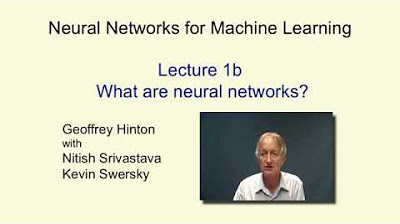How Neural Networks work in Machine Learning ? Understanding what is Neural Networks
Summary
TLDRIn this video, Jay Patel explains the concept of neural networks by drawing a parallel to the human brain's neuron network. He discusses how neural networks recognize patterns in input data to make predictions. The video covers the structure of a neuron, the role of activation functions, and the organization of layers in a neural network. It also touches on the importance of weights and biases in determining the network's output. The explanation is aimed at helping viewers understand the basics of neural networks before diving into more complex topics in subsequent videos.
Takeaways
- 🧠 **Understanding Neural Networks**: Neural networks mimic the human brain's ability to recognize patterns through a network of neurons.
- 👶 **Learning by Example**: Just like a baby learns to recognize fruits by seeing them repeatedly, neural networks learn patterns from input data.
- 🍎 **Pattern Recognition**: Neural networks can be trained to recognize patterns in images, such as distinguishing between apples and oranges.
- 💡 **Neuron Function**: A single neuron in a network functions as a simple function that outputs a value between 0 and 1, representing pattern recognition.
- 🌐 **Activation Functions**: Neurons are also known as activation functions that determine the output value based on the weighted sum of inputs.
- 📊 **Layered Structure**: Neural networks are composed of input, hidden, and output layers, each responsible for different aspects of pattern recognition.
- 🔢 **Input Layer**: The input layer's neurons correspond to the features of the input data, such as pixel values in an image.
- 🍏 **Output Layer**: The output layer provides a prediction, with the value indicating the probability of the input belonging to a certain class.
- 🤔 **Hidden Layers**: Hidden layers are crucial for capturing complex patterns and can vary in number and complexity based on the task.
- 🔗 **Connections and Weights**: Each neuron is connected to others with weights that are adjusted during training to improve pattern recognition.
- 🔄 **Training Process**: Neural networks start with random weights and are trained to adjust these weights to accurately predict outcomes.
Q & A
What is the primary function of a neural network?
-The primary function of a neural network is to recognize patterns in input data and make predictions based on those patterns.
How does the human brain's neural network relate to artificial neural networks?
-The human brain's neural network, with billions of neurons and trillions of connections, serves as an inspiration for artificial neural networks, which also use a network of neurons to recognize patterns.
What is the role of a single neuron in a neural network?
-A single neuron in a neural network processes input data and produces an output value, typically between 0 and 1, which contributes to recognizing patterns in the data.
How do neurons recognize different patterns?
-Different neurons store different values, which are responsible for recognizing various patterns. For instance, some neurons might activate for recognizing red color, while others might activate for orange.
What are the three types of layers in a neural network?
-The three types of layers in a neural network are the input layer, the hidden layer, and the output layer.
How is the number of neurons in the input layer determined?
-The number of neurons in the input layer is determined by the number of features in the input data. For example, if an image is 28x28 pixels with an RGB color schema, the input layer will have 2352 neurons.
What is the significance of the output layer in a neural network?
-The output layer provides the final prediction, with each neuron holding a value between 0 and 1, indicating the probability of the input data belonging to a certain class.
What are hidden layers and what is their purpose?
-Hidden layers are the layers between the input and output layers that are responsible for recognizing and holding patterns from the input data.
How are the number of neurons and layers in a neural network determined?
-The number of neurons and layers in a neural network depends on the complexity of the task and the amount of information that needs to be recognized. More complex tasks may require more neurons and layers.
What is the role of weights in a neural network?
-Weights are the parameter values assigned to the connections between neurons. They determine the emphasis given to certain patterns or regions in the input data.
How are the weights in a neural network initially set and how are they adjusted?
-Weights are initially set to random values. They are then adjusted through the training process, where the model learns to change the weight values to improve prediction accuracy.
Outlines

Esta sección está disponible solo para usuarios con suscripción. Por favor, mejora tu plan para acceder a esta parte.
Mejorar ahoraMindmap

Esta sección está disponible solo para usuarios con suscripción. Por favor, mejora tu plan para acceder a esta parte.
Mejorar ahoraKeywords

Esta sección está disponible solo para usuarios con suscripción. Por favor, mejora tu plan para acceder a esta parte.
Mejorar ahoraHighlights

Esta sección está disponible solo para usuarios con suscripción. Por favor, mejora tu plan para acceder a esta parte.
Mejorar ahoraTranscripts

Esta sección está disponible solo para usuarios con suscripción. Por favor, mejora tu plan para acceder a esta parte.
Mejorar ahoraVer Más Videos Relacionados

Konsep Artificial Neural Networks (Jaringan Syaraf Tiruan)

Introduction to Neural Networks with Example in HINDI | Artificial Intelligence

How Neural Networks Work

Unit 1.4 | The First Machine Learning Classifier | Part 2 | Making Predictions

Bentuk Otaknya AI | Pengenalan Artificial Neural Network

Lecture 1.2 — What are neural networks — [ Deep Learning | Geoffrey Hinton | UofT ]
5.0 / 5 (0 votes)
